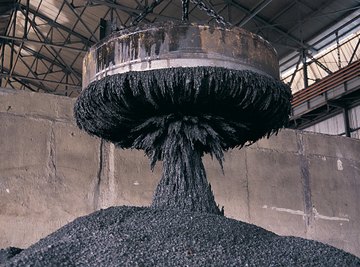
Magnets are atomic powered. The difference between a permanent magnet and a temporary magnet is in their atomic structures. Permanent magnets have their atoms aligned all the time. Temporary magnets have their atoms aligned only while under the influence of a strong external magnetic field. Overheating a permanent magnet will rearrange its atomic structure and turn it into a temporary magnet.
Magnet Basics
Materials with magnetic properties posses magnetic fields. A typical steel nail does not have a strong enough magnetic field to attract a metal paper clip. But magnetization can increase the strength of the steel nail's magnetic field. Simply placing a strong permanent magnet beside a steel nail will cause the nail to have a stronger magnetic field and act like a temporary magnet. The nail is referred to as a temporary magnet because once the permanent magnet is removed, the nail loses its magnetic field strength that attracted the paper clip.
Permanent Magnets
Permanent magnets differ from temporary magnets by their ability to remain magnetized without the influence of a nearby external magnetic field. Typically, permanent magnets are made from "hard" magnetic materials where "hard" refers to a material's ability to become magnetized and remain magnetized. Steel is an example of a hard magnetic material.
Many permanent magnets are created by exposing the magnetic material to a very strong external magnetic field. Once the external magnetic field is removed, the treated magnetic material is now converted into a permanent magnet.
Temporary Magnets
Unlike permanent magnets, temporary magnets cannot remain magnetized on their own. Soft magnetic materials like iron and nickel will not attract paper clips after a strong external magnetic field has been removed.
One example of an industrial temporary magnet is an electromagnet used to move scrap metal in a salvage yard. An electric current flowing through a coil that surrounds an iron plate induces a magnetic field that magnetizes the plate. When the current flows, the plate picks up scrap metal. When the current stops, the plate releases the scrap metal.
Basic Atomic Theory of Magnets
Magnetic materials possess spinning electrons around an atom's nucleus that individually exert a tiny magnetic field. This essentially makes each atom a tiny magnet within a larger magnet. These tiny magnets are called dipoles because they have a magnetic north and south pole. Individual dipoles tend to clump with other dipoles forming larger dipoles called domains. These domains have stronger magnetic fields than individual dipoles.
Magnetic materials that are not magnetized have their atomic domains arranged in differing directions. However, when the magnetic material is magnetized, the atomic domains arrange themselves in a common orientation and thereby act as one large domain that has an even stronger magnetic field than any single domain. This is what gives a magnet its power.
The difference between a permanent magnet and a temporary magnet is that once the magnetization stops, a permanent magnet's atomic domains will remain aligned and have a strong magnetic field, whereas a temporary magnet's domains will rearrange themselves in a non-aligned manner and have a weak magnetic field.
One way to ruin a permanent magnet is to overheat it. Excessive heat causes the magnet's atoms to vibrate violently and disrupt the alignment of the atomic domains and their dipoles. Once cooled, the domains will not realign as before on their own and will structurally become a temporary magnet.
References
About the Author
Since 1999, Timothy Boyer has worked as a freelance writer. His career began as a science columnist with "The Northwest Explorer" and as a science writer with McGraw-Hill publishing's Power Web Series of educational articles. Boyer has a Ph.D. in molecular and cellular biology from the University of Arizona.
Photo Credits
Stockbyte/Stockbyte/Getty Images
